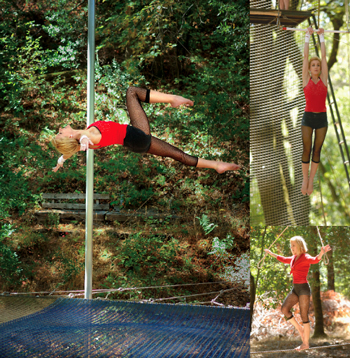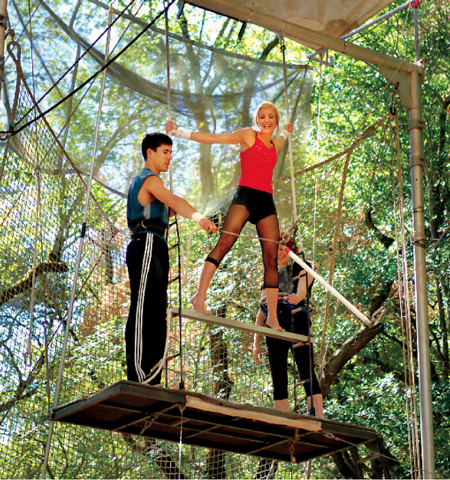Lizette Bumbesti has a busy schedule as a full-time hairstylist and mother of three. But at least four times a week, the 47-year-old makes time to fly through the air with the greatest of ease. The trapeze arts—various forms of aerial dance performed on a swinglike apparatus suspended anywhere from seven to 25 feet off the ground—are “not your typical yoga or Pilates class,” the Corte Madera resident concedes. “But it’s just something that grabs you and makes you want to keep coming back so you can get better and better at it.”
It may seem exotic, but Bumbesti’s not the only newcomer who’s hooked (so to speak). In fact, the part-acrobatics, part-dance technique has gained quite a following in the Bay Area. Five gymnastic-oriented schools now offer classes: in San Francisco the popular Circus Center has been teaching aerial skills, as well as a number of other circus arts like juggling and acrobatics, since it opened in the mid-1980s. Canadian-born Luc Martin leads daily trapeze classes for students of all skill levels in his Oakland-based school Pangym, and instructor Marek Kaszuba teaches enthusiasts on a private ranch in Sonoma every Saturday afternoon (for more on local classes, see the box on page 89).
Martin has been “flying” for over two decades and says his class enrollments have shot up significantly in recent years. Trapeze is “getting so trendy now,” he says. “I think Cirque du Soleil had a lot to do with popularizing it.”
In fact, trapeze artistry has been around since the late 19th century, when it was created in France by Jules Léotard, a gymnastics teacher’s son who also invented the eponymous one-piece garb that’s become today’s de rigueur dancewear. The trapeze act soon became a mainstay of circuses worldwide.
Nowadays, it’s usually performed by two or more people who use metal bars attached to cables to swing back and forth and catch each other midair. Martin says no special skills or equipment are needed to start learning the technique. “I actually specialize in beginners,” he adds, “taking normal people and preparing them for the trapeze.”
Usually he starts by teaching a few basic maneuvers on the ground. Classes tend to be small—no more than 10 people—so each person receives lots of personal guidance. It takes on average one month before a student is ready to actually get up on the trapeze—attached to a safety line, at first. Flying with no strings attached can take a number of years to master. Trapeze learners don’t all come from athletic backgrounds, Martin points out; his students range from Silicon Valley engineers to eight-year-olds to retirees seeking a new, exciting way to get their workout in.

Bumbesti got turned on to trapeze by a friend who’d discovered it on a Club Med vacation. She quickly fell in love with the art and started practicing regularly. “Anyone can do it, no matter [what] age, body type and size,” says Bumbesti, who recently began performing professionally on the trapeze. She was 43 when she started learning with Martin and other teachers, and “I’m just going to keep doing it as long as I can.”
Of course, if you’re scared of heights—safety line or no—you might opt for a seat on the bleachers. Luckily, more and more local venues are starting to showcase flying trapeze performances.
Check out San Francisco’s Teatro ZinZanni, where you might catch Bumbesti and partner Darrel Morrow gracefully swinging back and forth above your head.
Learning the Ropes
Circus Center
San Francisco; 415.759.8123
Head Over Heels
Gymnastics/Splash Circus Emeryville; 510.655.1265
hohgymnastics.com
Marek Kaszuba
Sonoma; 510.435.7359
marekkaszuba.com
Pangym
Oakland; 415.235.2488
pangym.com
Trapeze Arts
Oakland; 510.419.0700
trapezearts.com


